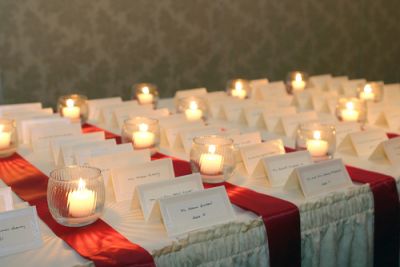 You’ve put a lot of time and effort into your wedding reception’s seating chart. Perhaps you had to navigate a minefield of difficult interpersonal dynamics while trying to ensure that you balanced guest numbers evenly at each table and accommodated disabled and elderly guests. So you’re done, right? Not a chance. You still need to execute your carefully crafted seating arrangements, but observing some useful tips can help you avoid stress and complications as you get ready for the big day.
You’ve put a lot of time and effort into your wedding reception’s seating chart. Perhaps you had to navigate a minefield of difficult interpersonal dynamics while trying to ensure that you balanced guest numbers evenly at each table and accommodated disabled and elderly guests. So you’re done, right? Not a chance. You still need to execute your carefully crafted seating arrangements, but observing some useful tips can help you avoid stress and complications as you get ready for the big day.
Document Your Plan
You’ll need some documentation of your setup. If nothing else, you’ll require it as a visual reference as you create and print any materials you need. Nancy Mattia mentions five digital tools that can help you plot and document your reception venue’s space in a March 2018 Brides article. Most include sharing, printing, and export functions that make it easy to keep your consultant, wedding party, and venue in the loop.
Escort, Place, and Table Number Cards
Now that you have a visual layout of your seating arrangement, you must create materials to help your guests find their places. Escort and place cards are a couple of key components for executing your plan successfully. Nearlyweds often confuse the two, but Wedding Wire’s Samantha Iacia clarifies that each item has its own unique purpose. Escort cards indicate the table to which each guest is assigned while place cards signal each attendee’s assigned seat. First, Iacia offers some wise suggestions on how to place and use escort cards:
- Make sure your escort cards are displayed in plain sight near your venue’s entrance.
- Arranging the cards alphabetically allows your guests to quickly find their own.
- A beautifully decorated welcome table can hold your guestbook and escort cards.
Conversely, place cards are displayed on the tables themselves. Each one usually rests either on a place setting or directly in front of it. Keep in mind that you’ll still need one place card for every guest, including young children and plus-ones who don’t have their own separate escort cards. As a bonus, you can use your place cards to indicate your attendee’s menu requests and if needed, special dietary requirements. Brides writer Jaimie Mackey suggests using icons, but you can also go with letters to stand for each entrée type.
Meanwhile, you shouldn’t leave out another important piece of your seating plan: table number cards. These are pretty straightforward, since they’re meant to let your guests know where their assigned tables are. Wedding blogger Emma Arendoski recommends several tips to ensure that you get the most out of your table cards:
- Table numbers should be easily visible from a distance, with bold print and a large font.
- Use table number card holders to display your cards.
- Print your cards on both sides so that the numbers are visible from either direction.
What About Printed Menus?
Menu cards are also a staple at most wedding receptions, but you can approach how you handle your menus a few different ways. A 2014 Brides article provides a few suggestions such as individual menus, calligraphed elegant placemat menus, or placing a couple of menu cards on the table if your meal’s buffet or family style. Individual menus or placemats can do double duty as place cards if you print each guest’s name on them as well.
A lot of work and organization goes into the logistics of your wedding reception. As a host, your job is to make sure that your guests are accommodated, comfortable, and happy. A well-planned seating arrangement is only the beginning. When supported by visually appealing and legible escort, place, and table number cards, your invitees can easily find their seats and enjoy your celebration.
Add Your Comment